The Rosewood Earrings Wire Weaving Tutorial

The Rosewood Earrings are a perfect match for the Rosewood Pendant tutorial, which was released last month. This pretty wire woven circle element is something that I’ve used before. You may well recognize it from my Three Sisters necklace.
I just recently got around to really exploring the many ways that this simple wire component can be used. And that’s how the Rosewood series was born. It started as an idea for a particular necklace design. And it’s morphed into a wonderfully modular wire element. I’m particularly pleased with the way the Rosewood bead frame has worked out for earrings.
These sweet little earrings are so beautiful. And I think you’re going to really appreciate the versatility of the Rosewood bead frame. With some very simple tweaks, you can dramatically change the look and feel of these darling little earrings. And you can use the Rosewood component for a multitude of fun and practical jewelry projects.
I chose a pair of pretty 11mm x 10mm Swarovski crystal briolettes for this tutorial. However, the Rosewood bead frame works beautifully with a wide variety of beads and dangles. Be sure to check out the Variations section at the end of this tutorial for some ideas. And then feel free to experiment with different beads, dangles, and focal elements.
Copyright & Disclosure
As always, you’re welcome to make and sell products from this tutorial on the condition that you credit Wendi of Door 44 Studios for the design and link back to this page.
When it comes to my written tutorials, however, I reserve exclusive rights to all images and written content. You may not reproduce or redistribute any portion of the Rosewood Earrings tutorial in any way, shape, or form. Furthermore, you may not teach the designs contained within this tutorial without my written permission.
This copyright applies to the printable PDF version of the fun and versatile Rosewood Earrings tutorial as well, and it’s included therein. Don’t forget, you may share the free version of this tutorial only by linking directly to this page.
This post may contain affiliate links. If you click on a link and then make a purchase, I may earn a small commission (at no cost to you). As an Amazon Associate I earn from qualifying purchases. To learn more, please see my full disclaimer.
Skill Level: Intermediate
This is a more challenging project that involves wire weaving. It can be achieved by someone who has some basic wirework skills.
Getting Started
You may use half-hard or dead soft solid jewelry wire for the core wires for this design. Because there’s no heat involved in the making of these earrings, this design will work just as well with brass or bronze wire as it does with copper or sterling silver. As usual, you’ll need dead soft wire in the same (or a compatible) alloy for weaving. If you choose sterling silver for your core wires, I recommend using dead soft fine silver for weaving and sterling silver wire for securing beads.
If you choose to use a filled wire, be aware that the bead frames are finished and hardened by hammering the wire. Even light hammering can expose the base metal core in filled wires, which can negatively affect your final finish. As always, I don’t recommend plated or anodized craft wire for these earrings. Those coatings will be ruined with this construction process.
How to Choose the Right Jewelry Wire
Jewelry wire is a constant source of confusion for beginners. I remember those days well! If you’d like to learn how to choose the right jewelry wire for wire weaving, be sure to read Jewelry Wire: Everything you need to know to make the best choice. In that post, I share everything you need to know about jewelry wire as you set out on your wire weaving journey.

Tools & Materials
- 20ga wire – 10.5 inches
- 30ga dead soft wire – 8 feet
- 11mm x 10mm Swarovski Crystal Briolette – 2 each
- 2mm accent bead – 2 each
- Wire Cutters
- Chain Nose Pliers
- Round Nose Pliers
- Stepped Bail-Making Pliers
- Nylon Jaw Pliers
- Needle File
- Chasing Hammer
- Bench Block
- Ring mandrel
- Ruler
- Fine Point Permanent Marker
- Sunshine® polishing cloths (optional). These are the polishing cloths that I use for dry polishing jewelry.
Finished Size
- WIDTH: about 3/4 inch (1.91 cm)
- LENGTH: about 1-1/8 inches (4.13 cm)
The overall finished length of your earrings will depend on the ear wires that you choose. I made my own matching copper French hooks, which added 1/2 inch to the total length of my earrings. If you’d like to make your own ear wires, be sure to check out my free tutorial, which will show you how to make perfectly matched ear wires, every time.
related posts
Useful Techniques & Companion Posts
Want a printable version of this tutorial?
How to Make the Rosewood Earrings
These instructions assume that you’re using 11mm x 10mm Swarovski briolettes, as specified in the materials list. However, this design can be easily adapted to any top-drilled beads.
I make recommendations for resizing the bead frame to fit smaller or larger beads in the Variations section of this tutorial. Refer to that section now if you’ve chosen to use focal beads that are substantially larger or smaller than the 11mm x 10mm Swarovski briolettes that I used. Otherwise, proceed with the instructions for the bead frame, as written.
Form the Bead Frames
Step 1
Measure and cut four pieces of 20g wire.
Cut two pieces at 2.5 inches long and the other two pieces at 2.75 inches.
File the ends smooth, if necessary, and mark the center of each wire with your permanent marker, as shown.

Step 2
Use your chasing hammer and bench block to paddle the ends of all four of the wires you cut in Step 1.
Then use your needle file to smooth and shape the paddled ends, if necessary.
We’ve now prepped the wires for both earring frames.
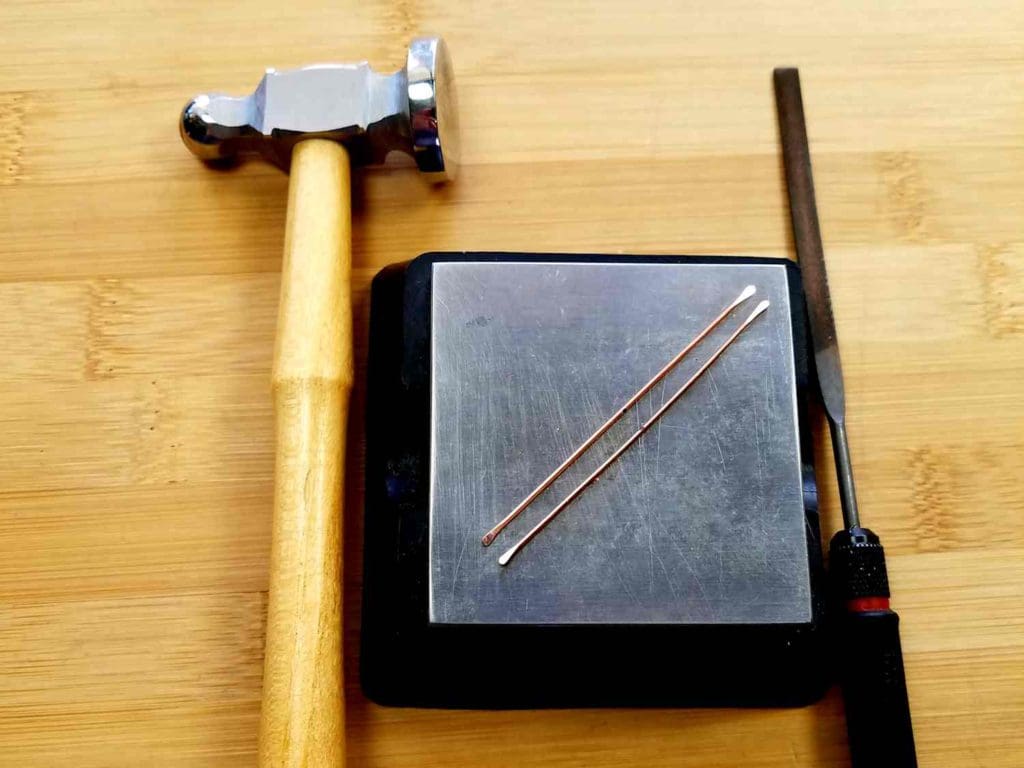
Step 3
Pick up one of the 2.5-inch 20ga wires that you prepped in Steps 1 and 2. We’ll call this Wire 1.
Using the tips of your round nose pliers, curl both ends of Wire 1 so that the curls are facing one another, as shown.
Repeat on the remaining 2.5-inch 20ga wire.
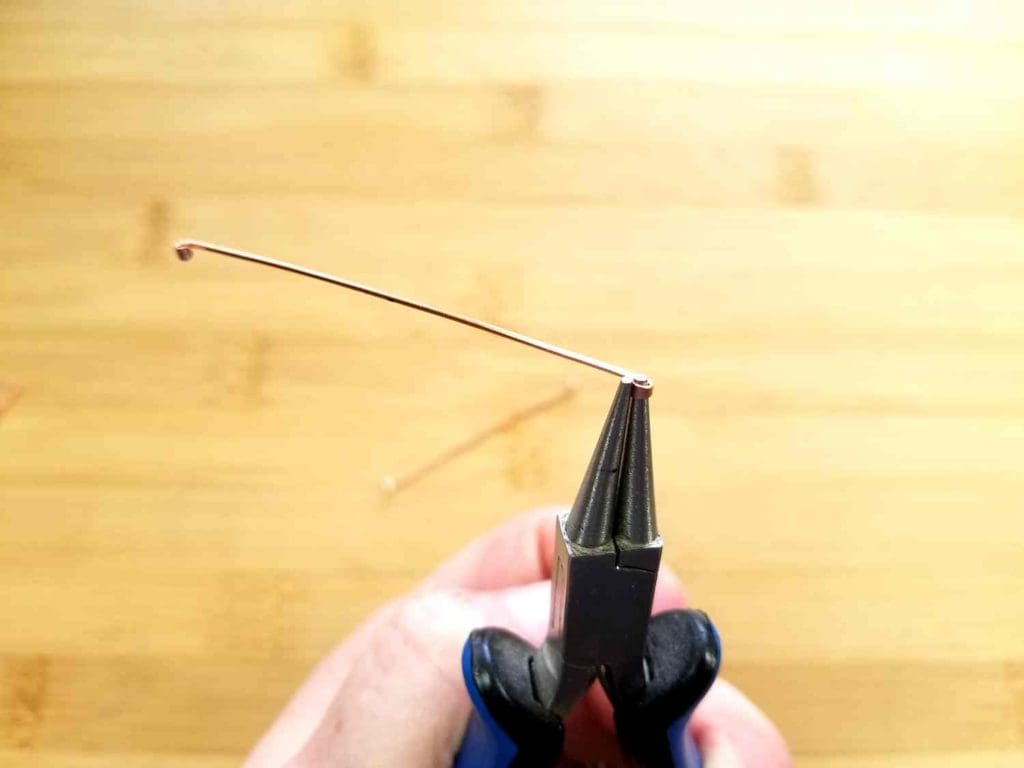
Step 4
We’re now going to form the curve on Wire 1.
Center your wire at the size 2 mark on your ring mandrel, making sure that the curled ends are facing up (away) from your ring mandrel.
Then gently bend the ends of the wire all the way around the ring mandrel. The ends of the wire will cross, as shown.
Repeat this step on the remaining Wire 1.
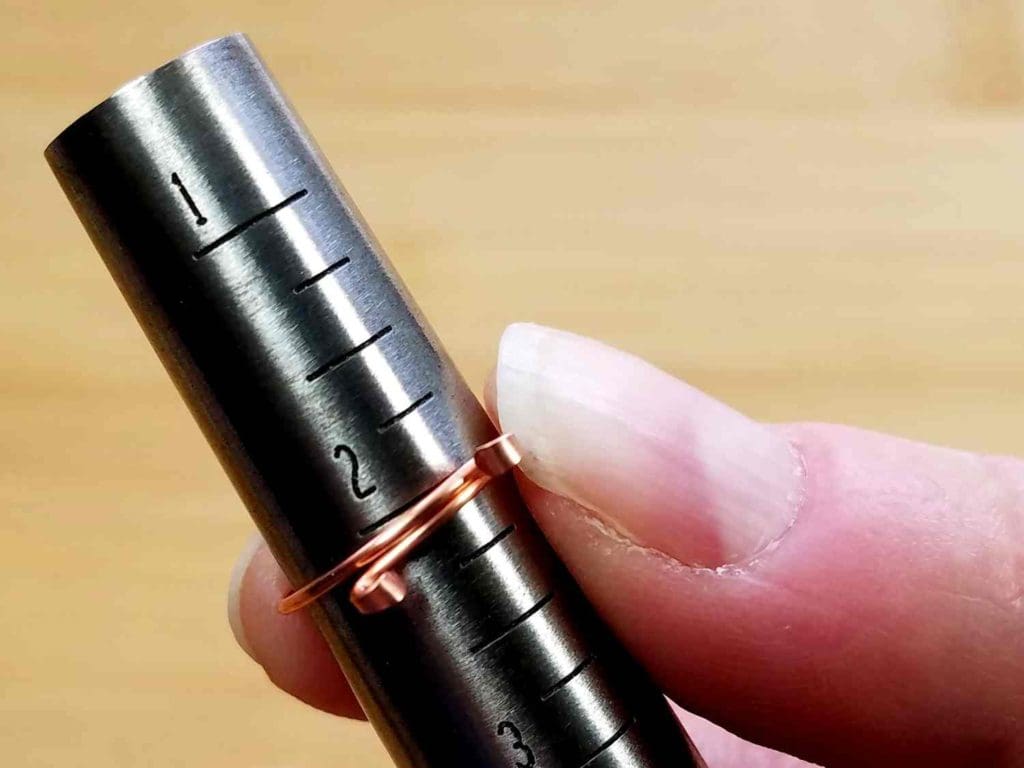
Step 5
Now, use the 2mm step (the smallest step) on your bail-making pliers to finish forming Wire 1 as shown.
This will be the inner core wire for one of your Rosewood Earrings bead frames.
Repeat this step on the remaining inner core wire.
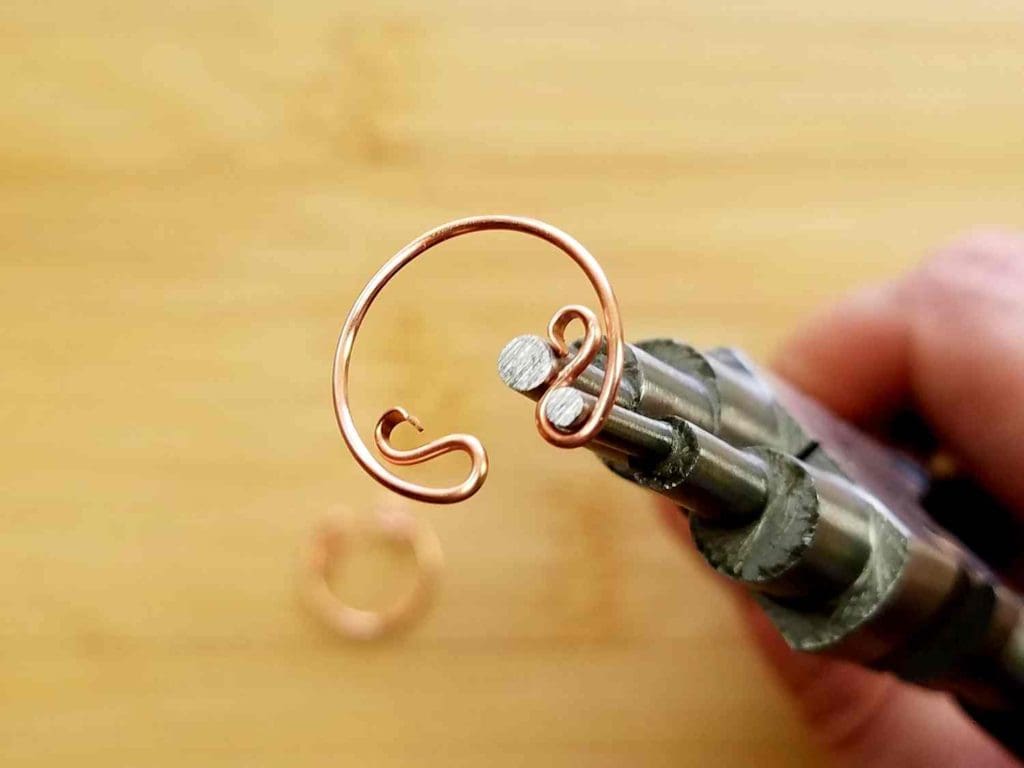
Step 6
The last step to forming Wire 1 is to lock those final bends into place.
Use your bench block and chasing hammer to lightly flatten just the rounded ends of Wires 1. Be careful to avoid damaging the small curls with your hammer.
If hammering the ends opens the gap between the core wire and the small curls on the ends of your wire, just squeeze it closed with the tips of your round nose pliers.
This completes Wires 1. Set them aside for now, and we’ll form Wires 2 next.

Step 7
Use the tips of your round nose pliers to form small curls on both ends of one of your 2.75-inch 20ga wires. Again, make sure that the curls are facing one another, as shown.
Repeat on the remaining 2.75-inch wire. These are the outer core wires of your bead frames. We’ll call them Wire 2.

Step 8
Use the 2mm step (the smallest step) of your bail-making pliers to finish forming the curled ends on both ends of Wire 2, as shown.
Repeat on the remaining Wire 2.
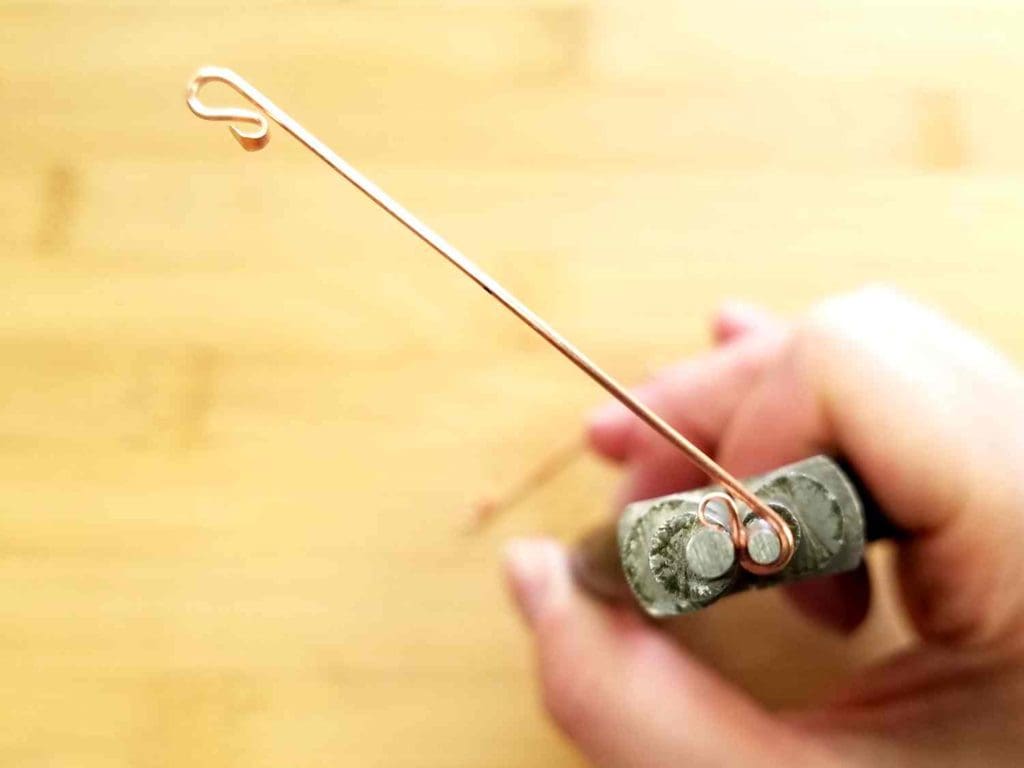
Step 9
We’re now going to lock those curved ends in by work hardening them.
Use your chasing hammer and bench block to flatten just the large curve at each end of your two outer frame wires.
Again, be careful to avoid marring your small curls with the hammer and tighten the gap between the core wire and the small curls with your round nose pliers, if necessary.
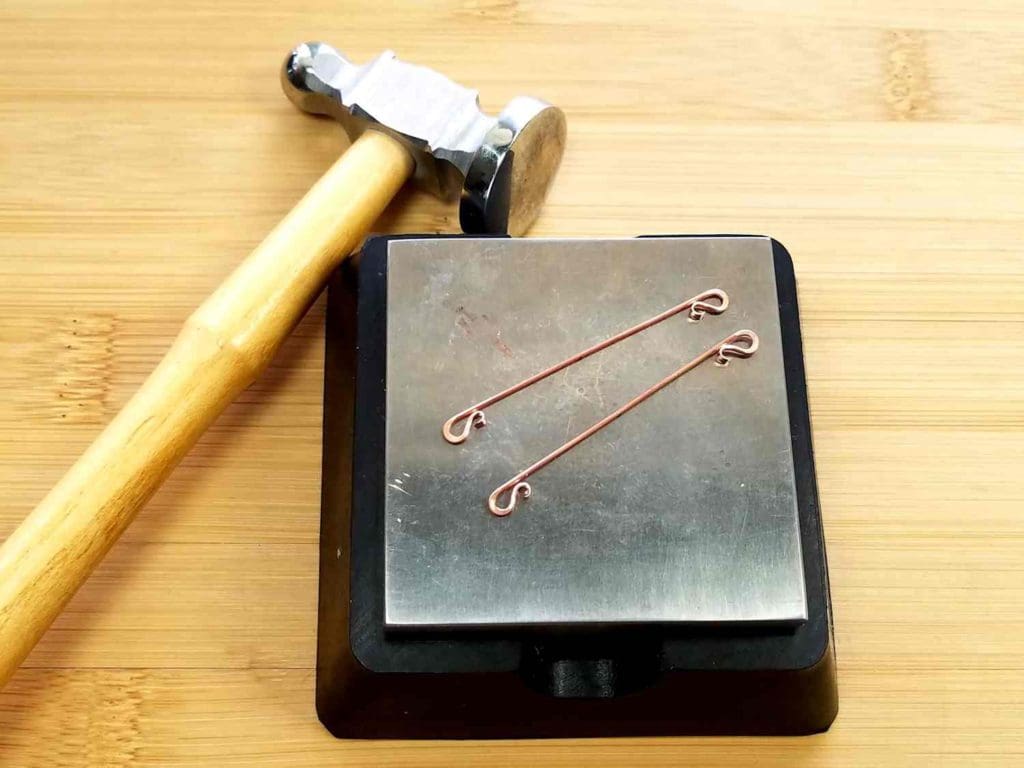
Step 10
The last step is to form the curves on Wires 2.
Center your core wire at the Size 5 mark on your ring mandrel. Make sure that the curled ends are facing up (away) from your ring mandrel, and then gently bend the ends of that wire around the ring mandrel.
Repeat this step on your second Wire 2.
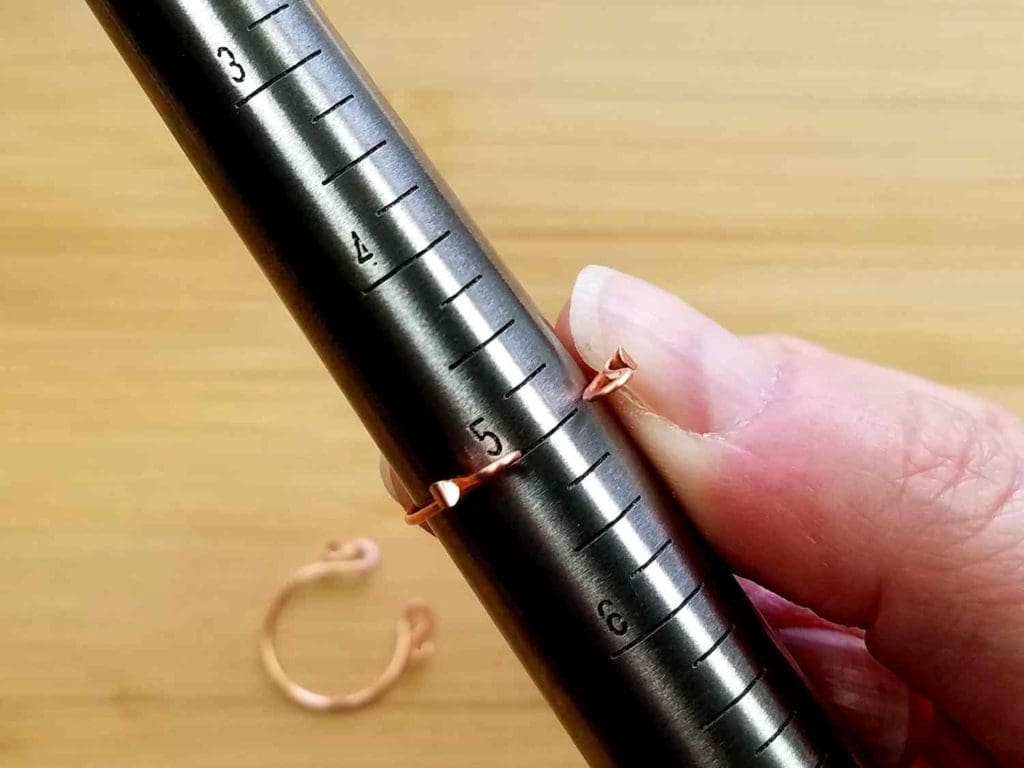
Your four core wires are now fully formed. Nest them together and make sure they fit neatly, as pictured here.
Make any final adjustments necessary before proceeding to the weaving section of this tutorial.

Weave the Core Wires Together
Step 1
You’ll need about 8 feet of dead soft 30g wire for weaving (4 feet per earring frame).
I like to work off a bobbin when dealing with this much wire. Wind your bobbin with more than enough wire to complete the weaving for this project.
I usually wind my bobbins with between 50 and 100 feet of wire, and then I use that bobbin for multiple projects.
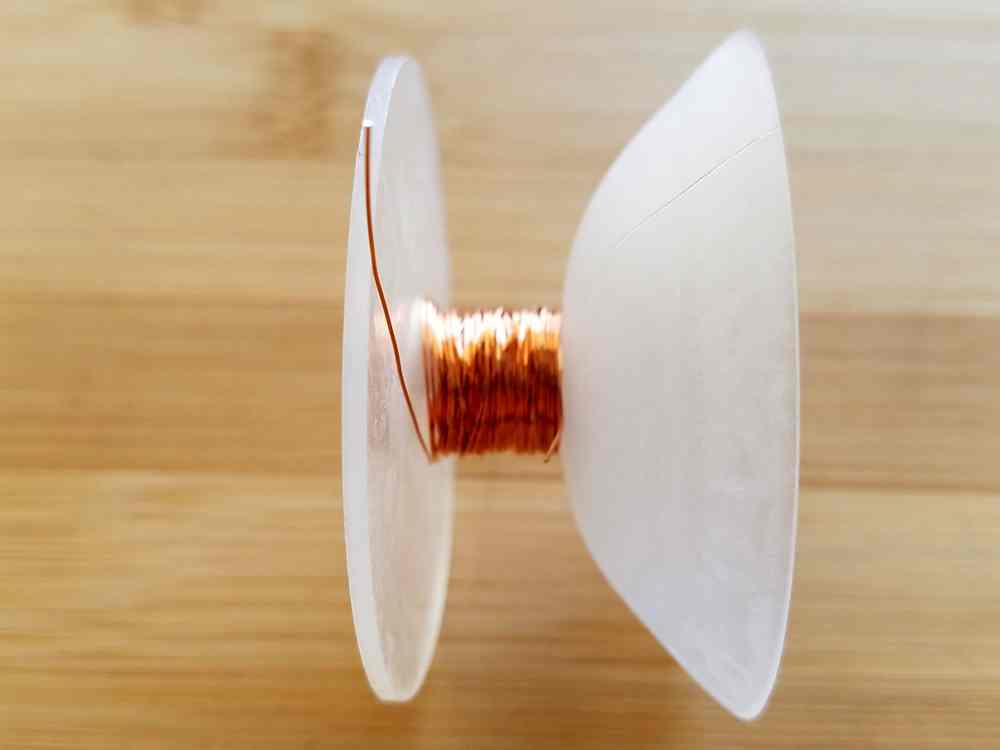
Step 2
Before we start weaving the core wires together, we’re going to mark the wires in four places. These marks will help you keep your core wires properly aligned while you weave them together.
Make sure that Wire 1 is centered within Wire 2. Slide them around, if necessary, until you get them precisely centered.
Once your core wires are properly aligned, use your fine-point permanent marker to mark both wires at the four points where you will begin and end your weave, as shown.
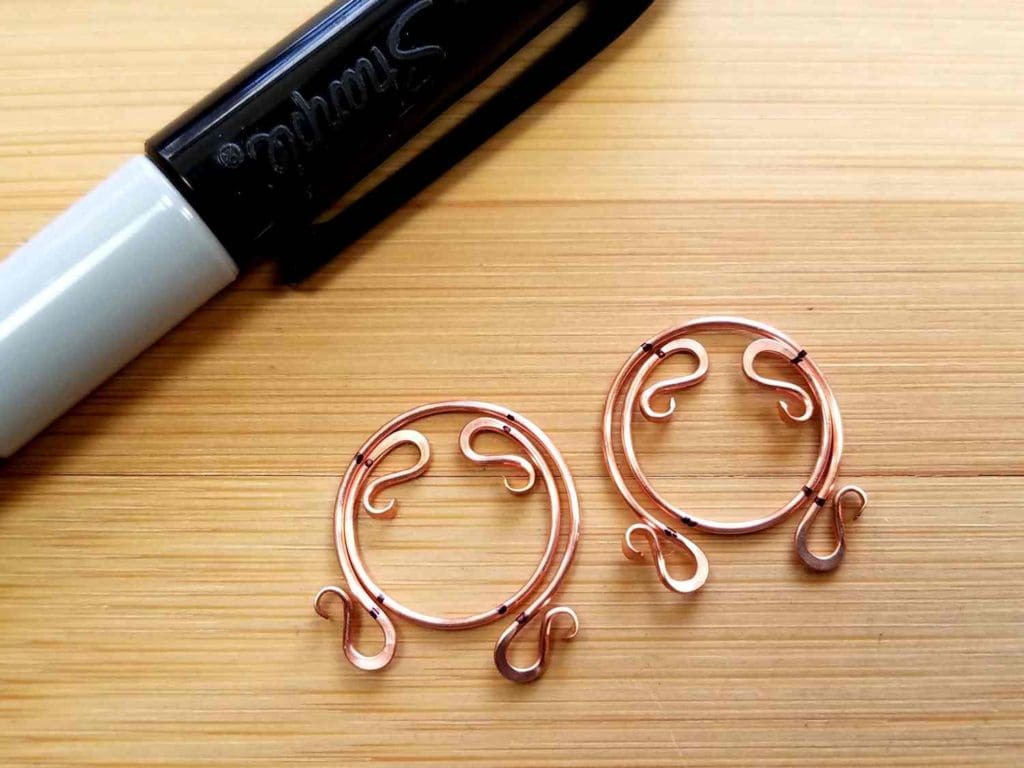
Step 3
Now, starting at the marks at the top of your bead frame that feel most natural to you, leave a 3-inch tail and begin weaving Wires 1 and 2 together using the Modified Soumak Weave.
Continue weaving the first side of your core wires until you reach the first small curl on Wire 2. Then pull about two feet of weaving wire from your bobbin and cut that length of wire off the bobbin.
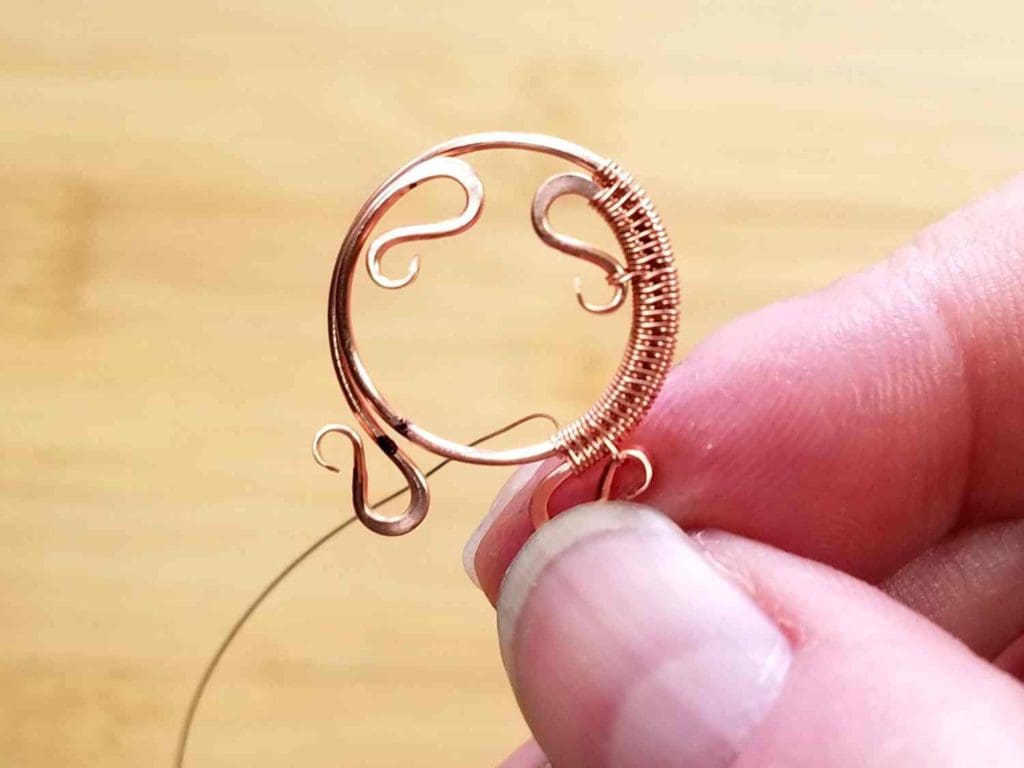
Step 4
Continue your weave where you left off making sure to lash the small curl on Wire 2 to your core with a single pattern repeat.
Then continue weaving the closed end of the curl on Wire 2 to Wire 1 until you reach the point where the two wires diverge.
Coil your weaving wire around Wire 1 until you reach the marks where your weave should begin, as shown.
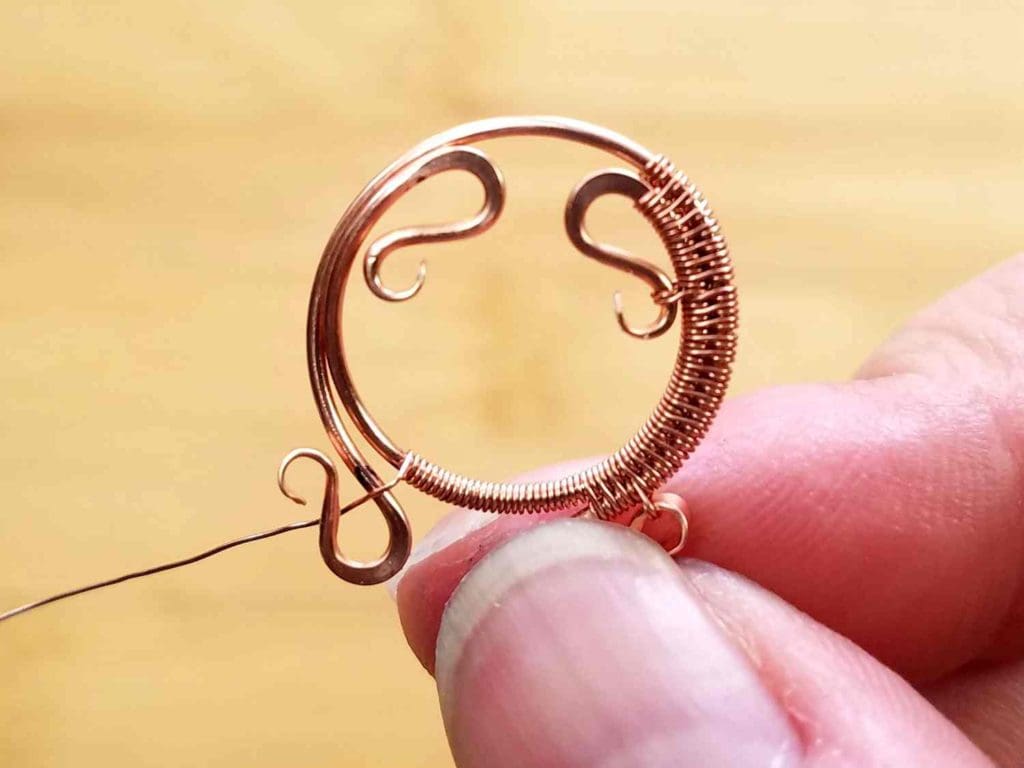
Step 5
Continue weaving in pattern until you reach the point at the top of the bead frame where the two core wires diverge.
Then finish off your weave with three wraps around Wire 2 and break your weaving wire. Finally, wrap the starting tail of your weaving wire three times around Wire 2 and break it as well.
Repeat Steps 3 through 5 on the remaining pair of core wires to complete your second earring frame.
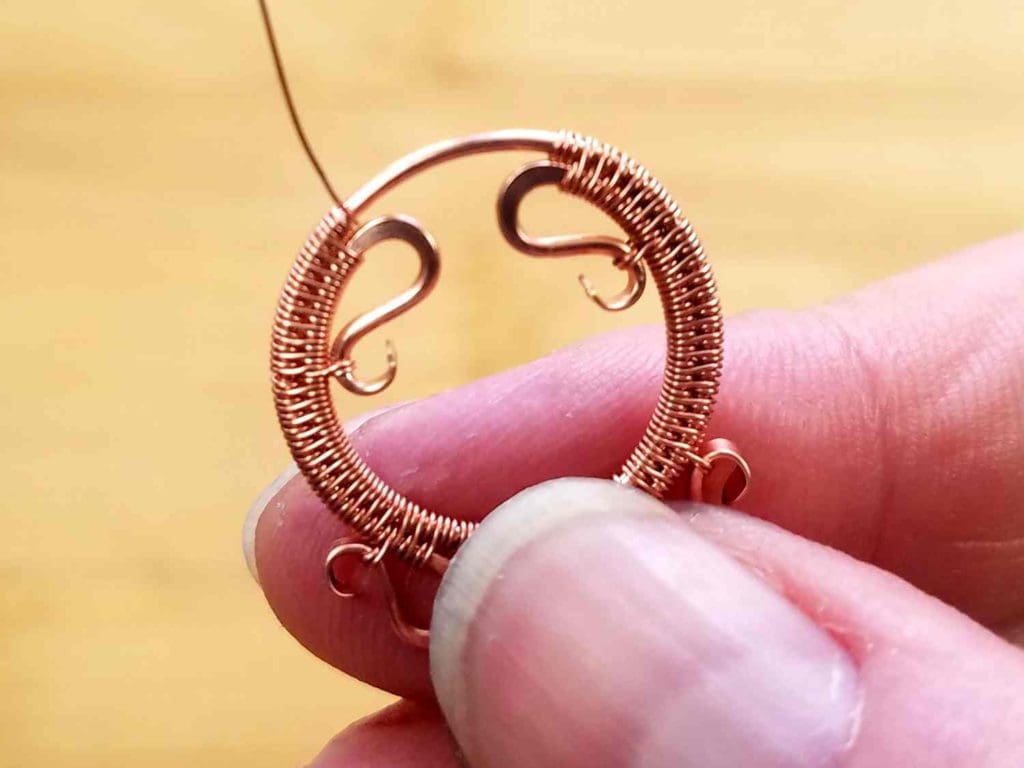
Suspend the Focal and Accent Beads
Step 1
Use your fingers to gently push Wire 1 forward and Wire 2 backward, as shown. If necessary, push the curved ends of Wire 1 slightly forward and the curved ends of Wire 2 slightly backward so they continue the curve of the bead frame.
This adds an attractive sculptural dimension to your Rosewood Earrings.
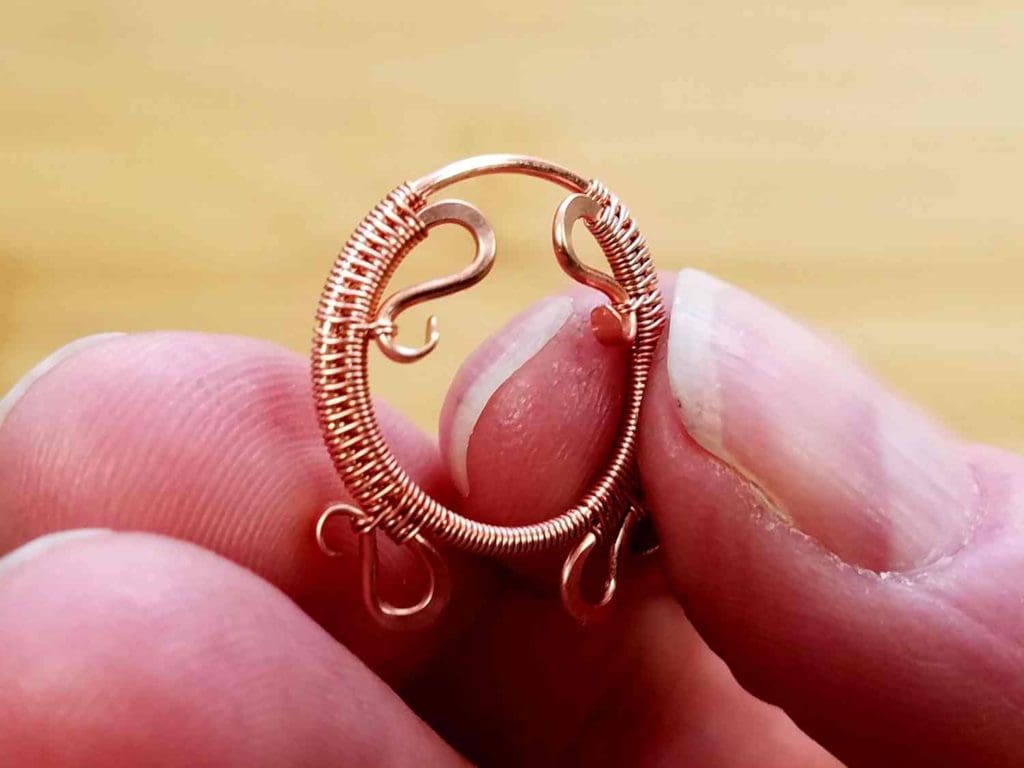
Step 2
Using a scrap piece of 30ga weaving wire that you have left after weaving your two earring frames, wrap a 3-inch tail of the wire twice around one of the curled ends of Wire 1, as shown.
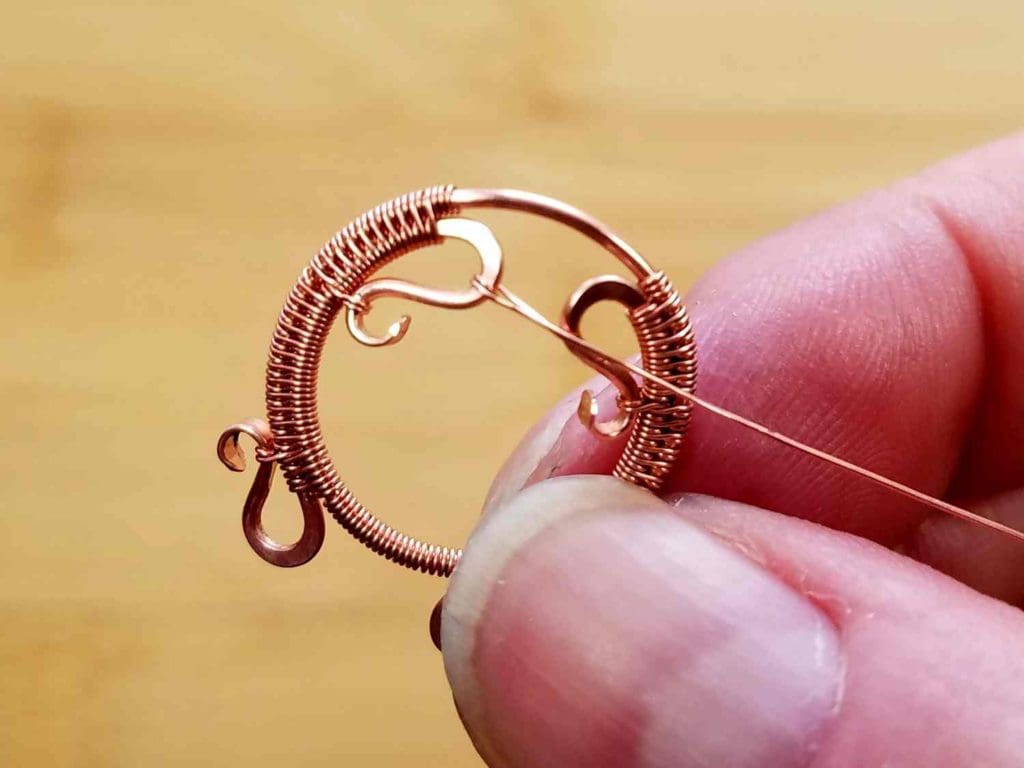
Step 3
Now thread your 2mm accent bead onto both wire ends attached to the bead frame, as shown.
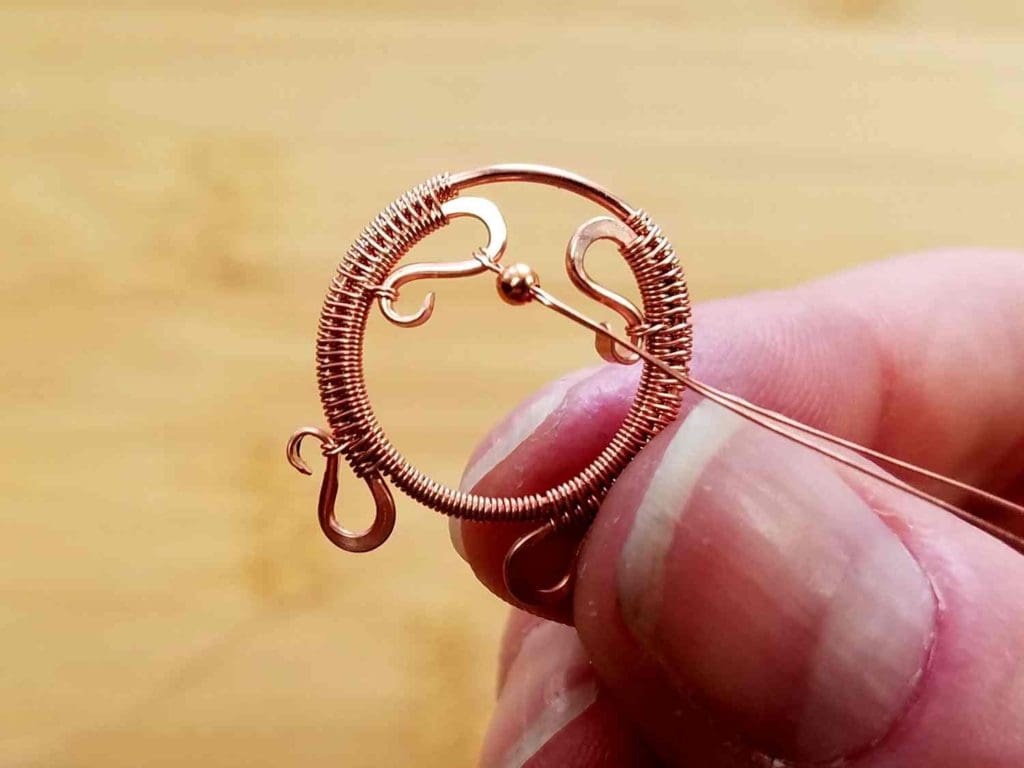
Step 4
Take the longer of the two wires passing through your accent bead and wrap it twice (neatly and tightly) around the other curved end of Wire 1.
Then feed the end of that wire back through the accent bead one more time.
You should now have three passes of wire going through the bead. Pull the suspension wire snug, making sure to avoid kinks as you do so.

Step 5
Finally, finish off your bead suspension by wrapping the tails of the wire at least two times around the three wires passing through your bead.
Break the tails off on the back of your bead frame (the concave side) and tuck the ends in neatly with chain nose pliers or a beading awl, if necessary.
Your bead frame should now look something like the one pictured here.

Step 6
We’re now going to attach the focal briolette using the same technique that we used for the accent bead.
Start by finding the center of your remaining scrap wire and wrap the wire twice around one curved end of Wire 2, as shown.
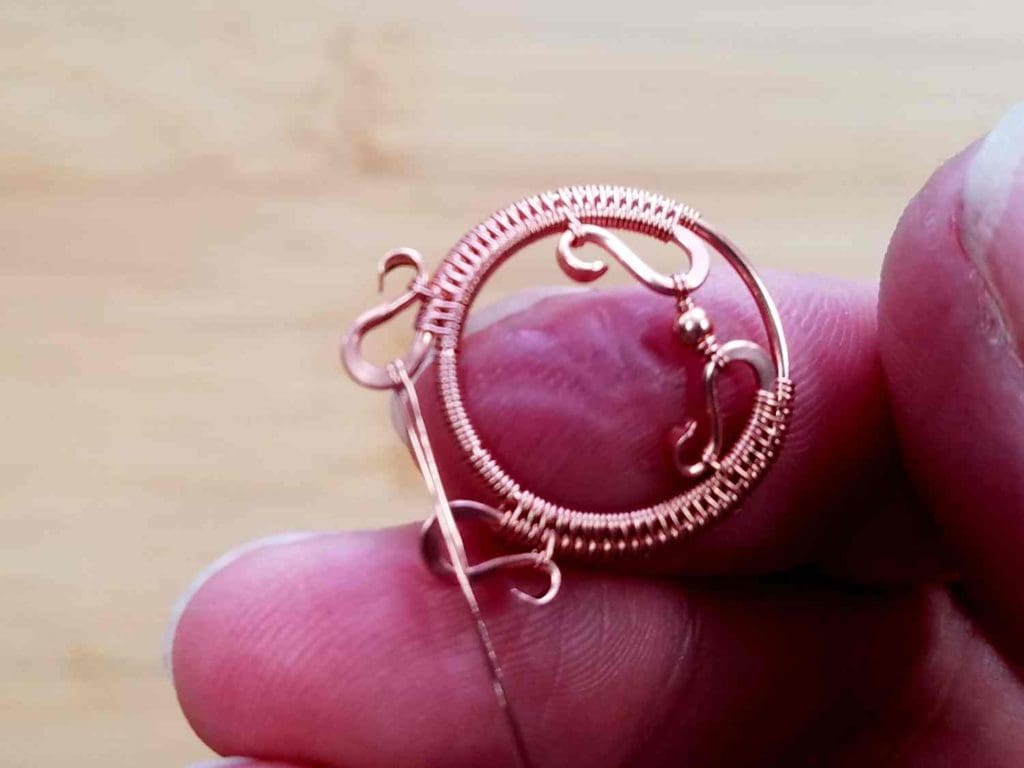
Step 7
Thread your focal bead onto the two wire ends. Then wrap one of those ends twice, tightly and neatly, around the remaining curved end of Wire 2.
Finally, feed that same end of wire once more through your focal bead until you have one wire tail on each side of the bead, as shown.
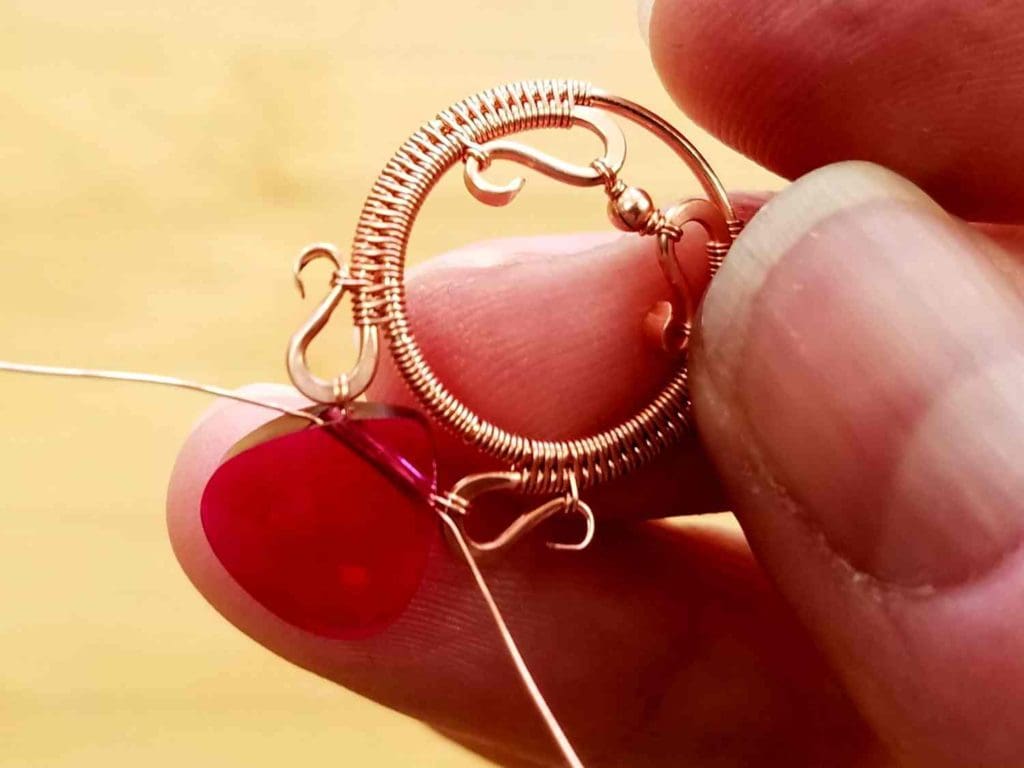
Step 8
Finish off your focal bead by wrapping the wire tails tightly and neatly at least three times between the wire frame and the bead.
Break your wire tails on the back side of the bead frame, as shown. Tuck in the ends with chain nose pliers or a sharp beading awl, if necessary.
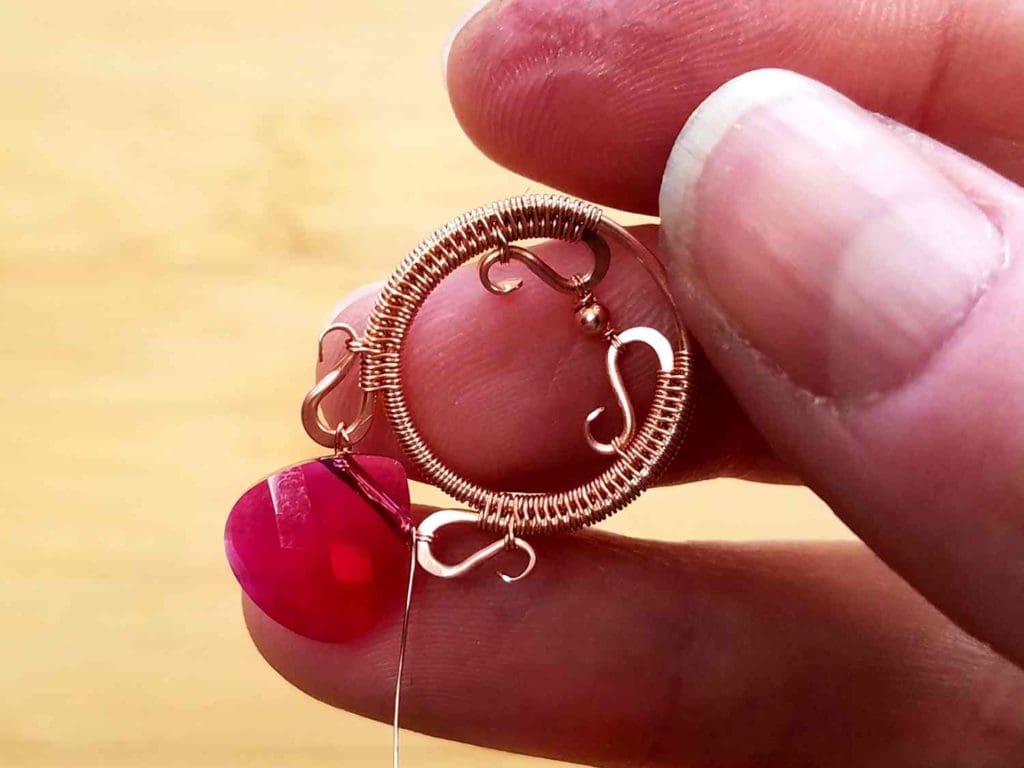
Your first earring dangle is now complete and ready to hang on an ear wire.
Repeat Steps 1 through 8 to finish the pair.

Variations of the Rosewood Earrings
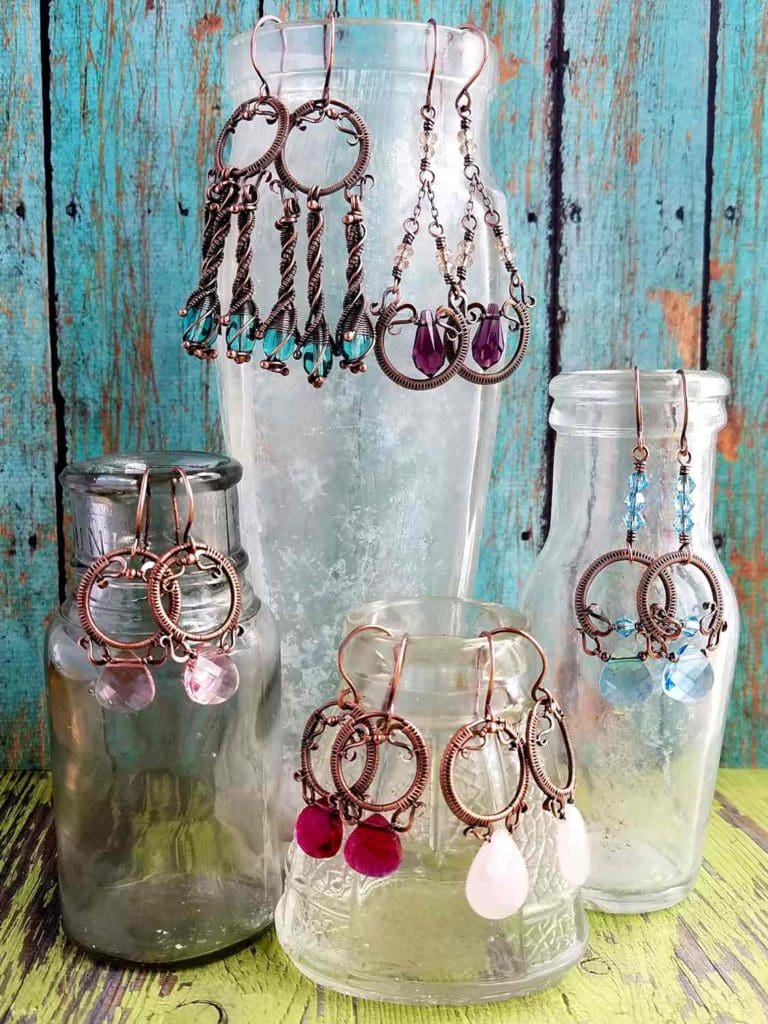
Beads that work well for these earrings are easy to locate, and this design can be easily adapted to top side-drilled beads of nearly any size and shape. The bead frames, as sized in this tutorial will accommodate a variety of top-drilled beads including gemstone briolettes, crystal points, and even my Twig Pendants.
You can completely change the look of the bead frames by simply re-positioning Wire 1 so that the ends of both core wires meet in the center of the frame. The two pairs of earrings pictured on the top and middle right were created this way.
Notice how different those earrings look depending on how the bead frame is oriented. I used the same basic variation of the wire woven Rosewood Earrings on the Amethyst pair pictured top right. Only this time, I flipped the component upside down and suspended an Amethyst colored crystal within the frame for a more classic chandelier-style earring. The blue earrings pictured middle right have a cleaner and more contemporary look. These earrings were made with the same frame variation. The only difference is in the way that the frame is oriented.
Combine with Other Jewelry Elements
Experiment with this design. I think you’ll find that it’s very versatile and works beautifully with a number of other jewelry components like tassels or one or more Twig Pendants. The Three Sisters Earrings, pictured top left, are simply a combination of the Rosewood Earring component and three dainty Twig Pendants dangled from each Rosewood Earring frame.
The principles for forming and weaving the core wires are the same regardless of the size of your focal beads. All that you need to change to resize your bead frame are the wire gauges that you choose, the cut lengths of your core and weaving wires, and the size of the mandrels that you use to shape those wires.
If you don’t get the lengths for your core wires just right, you can always fine-tune any gaps between your focal beads and your bead frame by using metal spacer beads. Be sure to keep good notes on the ideal lengths for your core wires and mandrels so you can easily repeat your modified design.
Finishing Your Rosewood Earrings
I antiqued the Rosewood Earrings that I made while writing this tutorial with Liver of Sulfur (LOS). And then I burnished the antiqued piece with super fine steel wool (Grade #0000) in a warm bath of water and original Blue Dawn dish soap. The steel wool brought back the bright copper highlights on the high spots.
Once that’s done, I rinsed the jewelry thoroughly to remove any particles of steel wool. And then I put my earrings in a tumbler barrel filled with warm water and a generous squirt of Blue Dawn. I tumbled each pair for about two hours.
If you’re new to wire weaving, be sure to read this detailed tutorial that walks you through my 7-step patina process. And if you’re wondering why I recommend tumble polishing specifically, check out this post. Also, be sure to clean your stainless steel shot regularly. Clean shot is necessary to achieve the best finish on your tumble-polished jewelry.
One last bit of tumbler advice before you go. Always make sure that any beads or stones that you use for your jewelry are safe to tumble. I don’t recommend tumbling natural pearls, soft gemstones, ceramic beads, or glass beads with polymer coatings, such as glass pearls and certain frosted-look glass. As always, if you’re unsure if your beads can handle the tumbler, run a test tumble with a bead that you’re willing to sacrifice.
Discover More Behind Door 44
Thanks so much for joining me today. I hope you enjoyed creating my pretty and versatile Rosewood Earrings. If you’d like a printable PDF version of this tutorial, click the button below.
Want a printable version of this tutorial?
Want more free wire jewelry tutorials and tips?
I like to share useful wire weaving tips and tricks on my social media channels, and we have some great conversations about wire jewelry in my private Facebook Group. Also, be sure to connect with me @door44studios on Instagram, and Facebook to keep up with everything that’s happening behind Door 44. And if you haven’t already done so, be sure to subscribe to my YouTube channel where you’ll find new wire jewelry videos weekly.
Until next time, go make something beautiful!

Pin the Rosewood Earrings Tutorial for Later
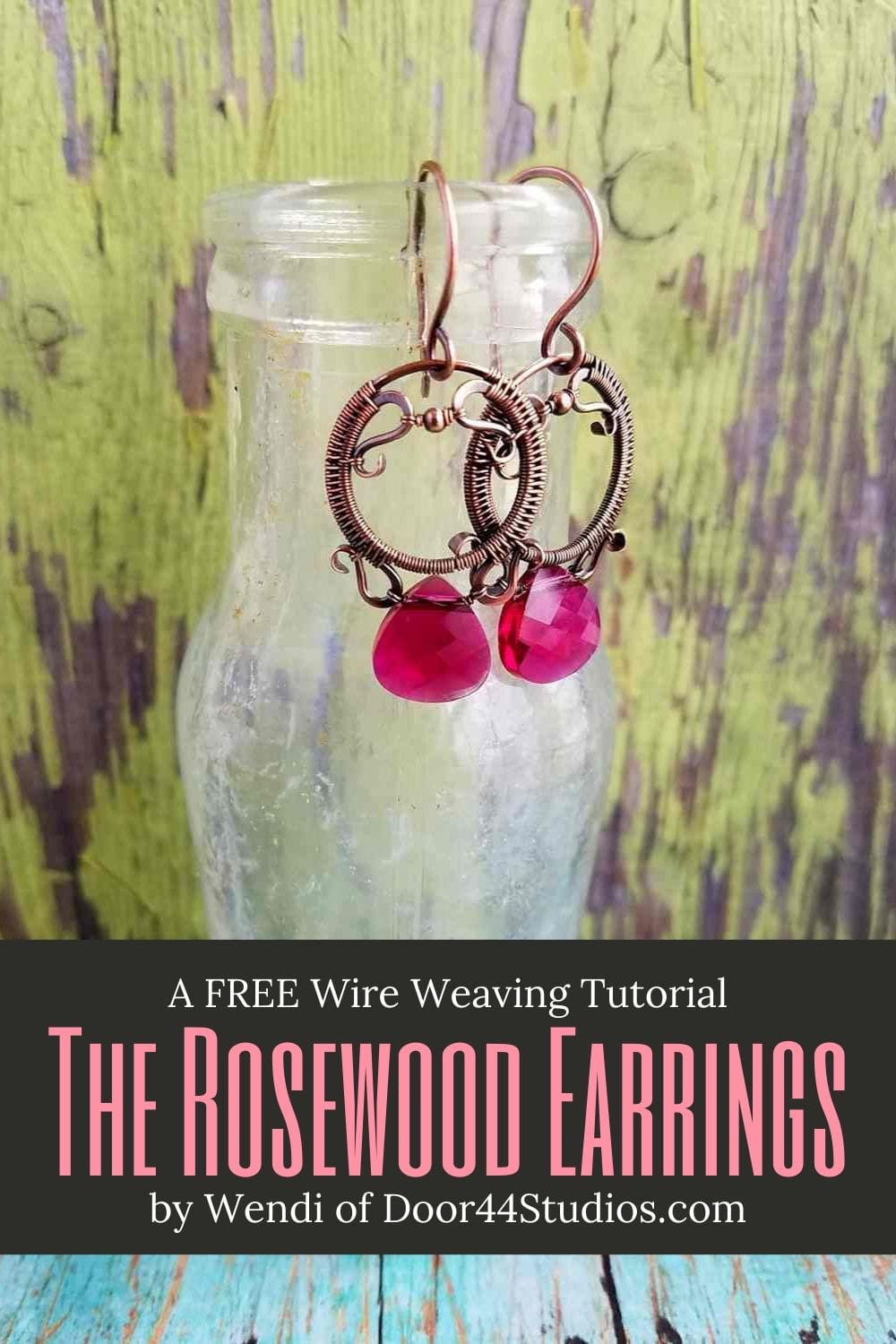



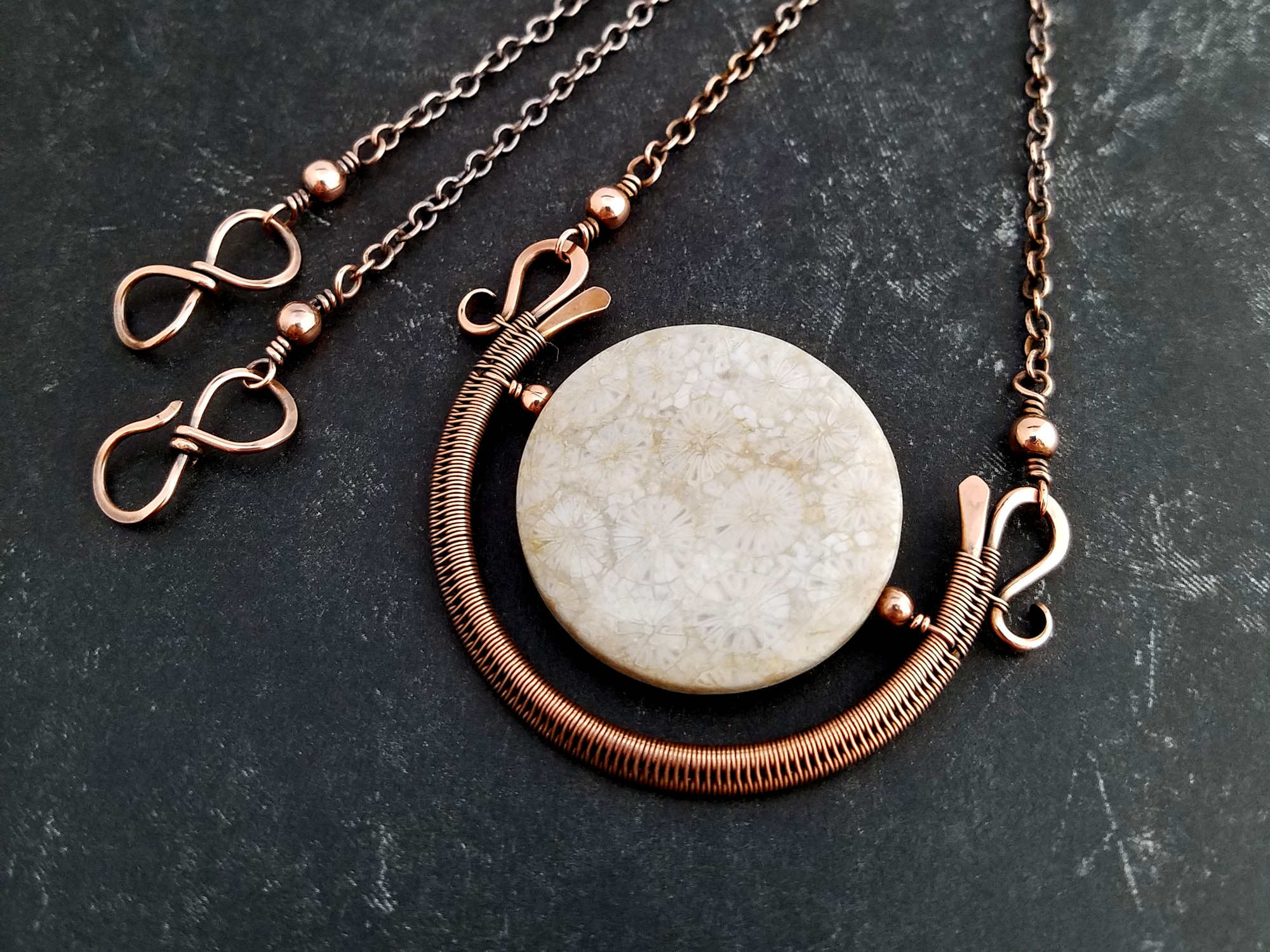

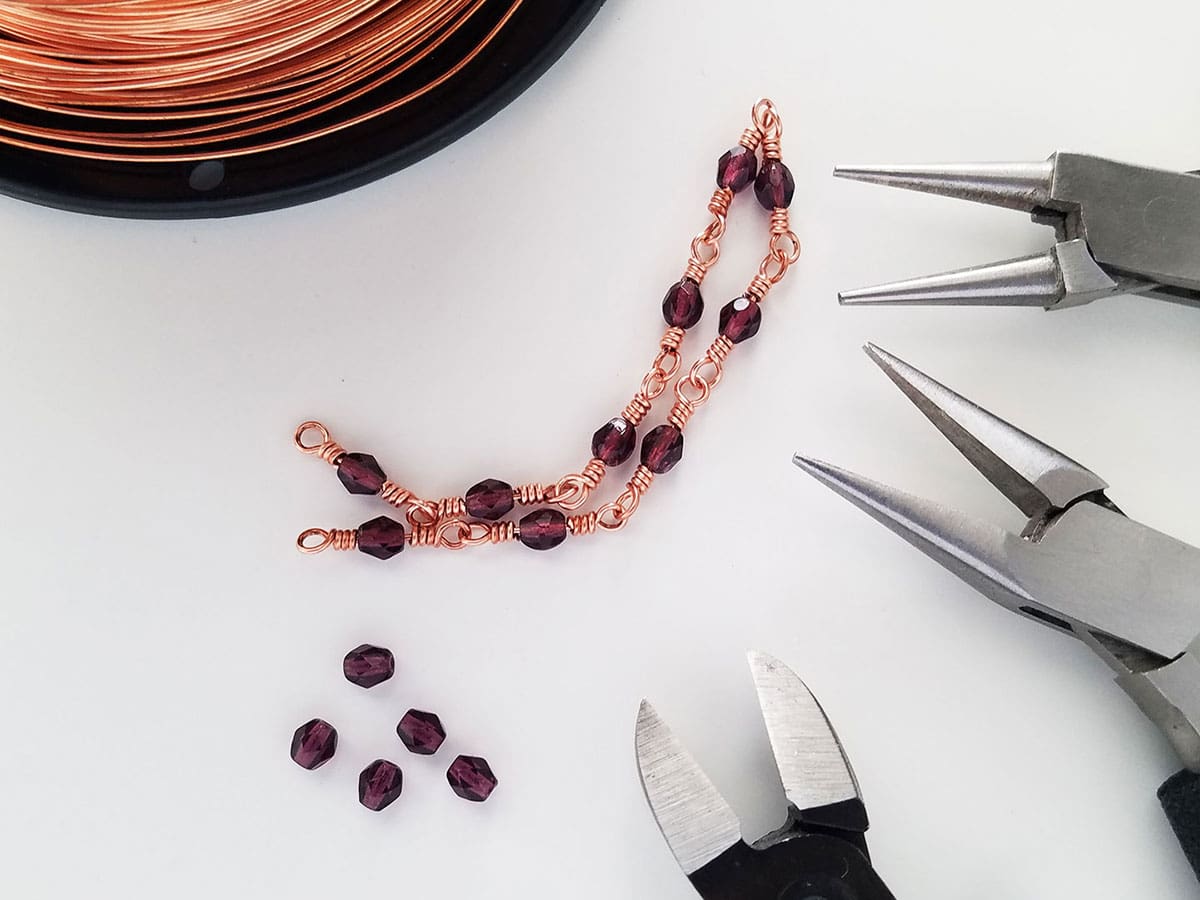

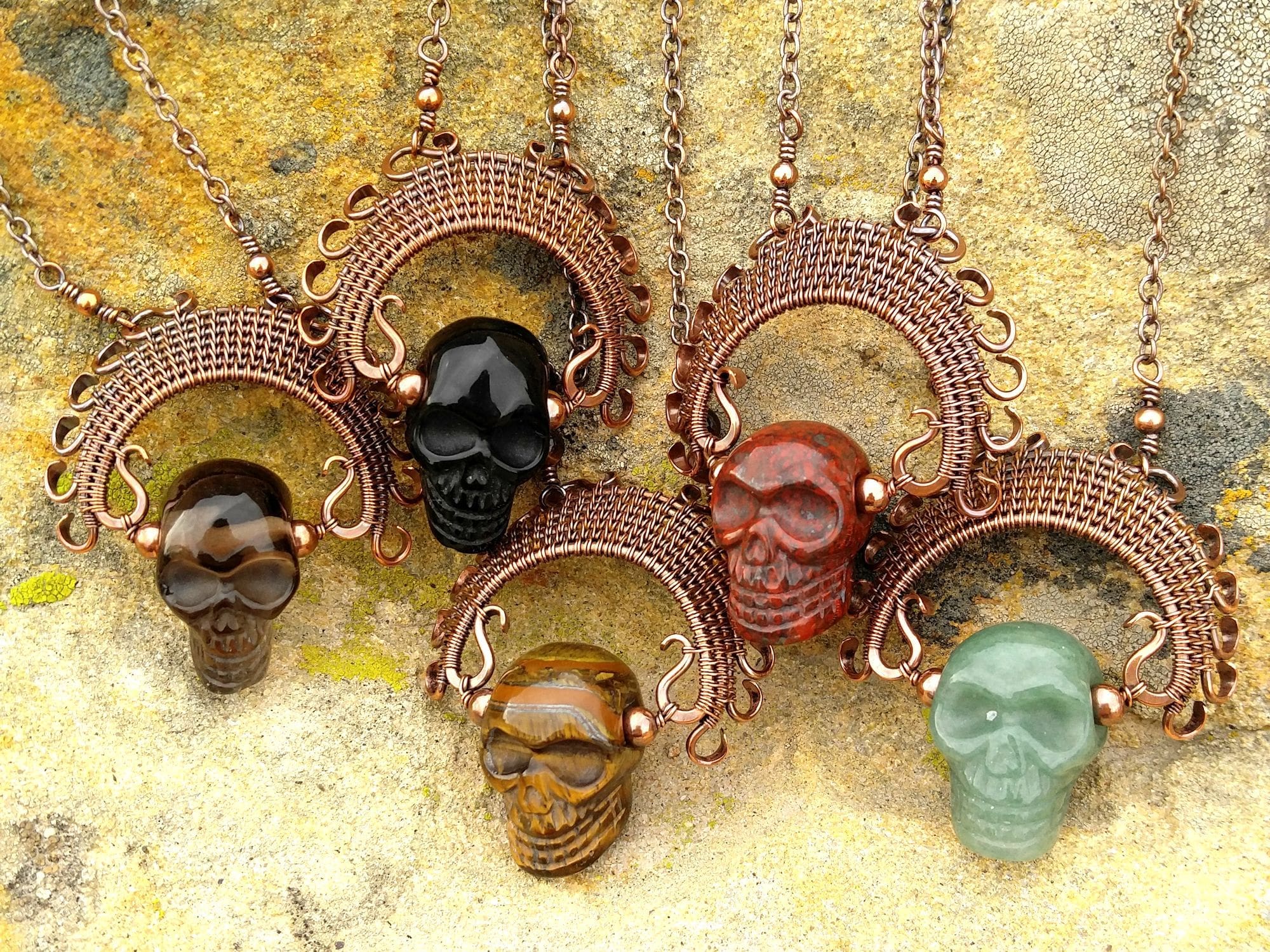

Thank you! They are gorgeous!
You’re welcome. Enjoy!
Going shopping for tools and wire, I have to try this. Look so good
That’s great, Robert! I hope you enjoy the tutorial. Please let me know if you have any questions!
After burnishing with steel wool, I run a strong magnet over the whole piece. You will be surprised how much steel wool bits it picks up.
Thank you for all the tutes. I’ve learned alot from you!
That’s a brilliant idea, Crystal! Thanks so much for sharing it with other readers. And you’re very welcome for the tutorials. I’m so glad you enjoy them!